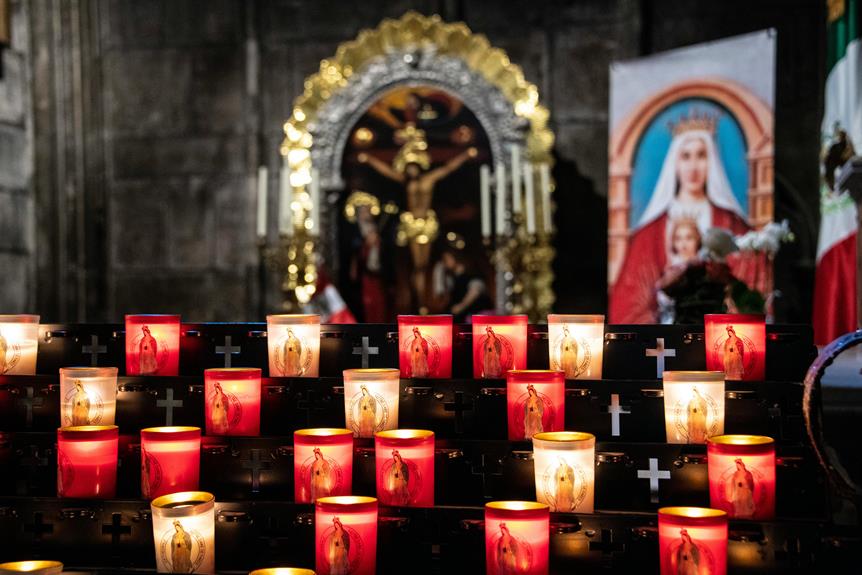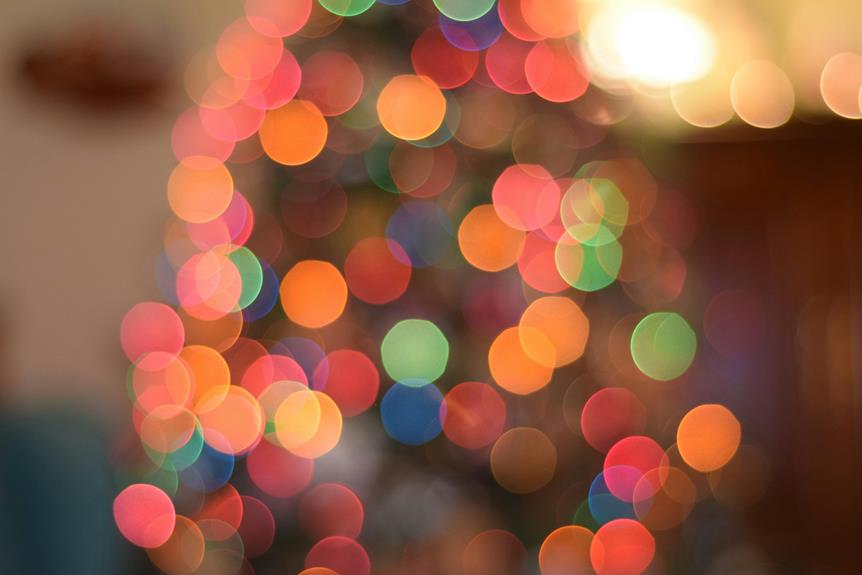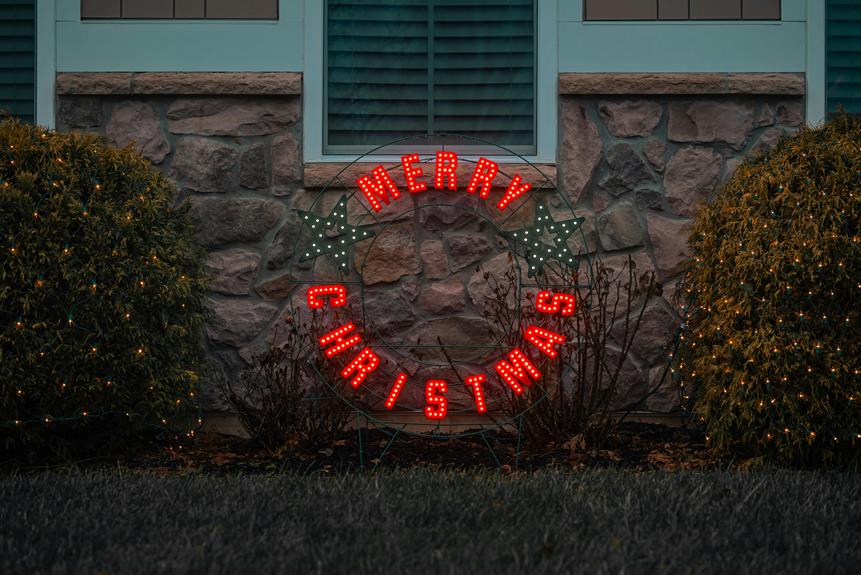As you string up your Christmas lights, you're part of a centuries-old tradition that's evolved from candlelit trees in 17th-century Germany to today's dazzling LEDs. You've probably used candles, electric lights, incandescent bulbs, and neon lights in the past. But LEDs have revolutionized holiday decorating with their energy efficiency, durability, and design flexibility. They come in a vast array of colors and styles, are cool to the touch, and can last up to 25 times longer than traditional lights. And there's more to the story – from safety features to modern marvels of illumination, there's still so much to discover about the magic of Christmas lights.
Key Takeaways
- Candlelit Christmas trees originated in 17th-century Germany, evoking a sense of Victorian traditions with gentle, warm lighting.
- Electric lights replaced candles in the late 19th century, offering a safer and more convenient alternative with Thomas Edison's innovations.
- Incandescent bulbs dominated Christmas lighting for decades, providing a warm, soft glow and enabling intricate designs and patterns.
- LED lights revolutionized Christmas decorations in the 21st century, offering unparalleled energy efficiency, durability, and design flexibility.
- Modern LED lights prioritize safety, featuring fire-resistant materials, waterproof coatings, and cool-to-the-touch designs for a worry-free holiday season.
Candlelit Christmas Trees
You can create a warm and inviting ambiance by adorning your Christmas tree with candlelit ornaments, a traditional practice that dates back to 17th-century Germany.
This nostalgic approach evokes a sense of Victorian traditions, where families would gather around the tree, mesmerized by the soft, flickering glow of candles.
The gentle light dancing across the room creates a magical winter ambiance, perfect for snuggling up by the fireplace with a cup of hot cocoa.
To achieve this look, you can use candles made from natural wax or soy, which provide a warm, soft light.
You can place them inside glass ornaments or hang them from the branches using ribbons or twine.
Be sure to take necessary safety precautions, such as placing the candles on a heat-resistant surface and keeping them away from flammable materials.
The Advent of Electric Lights
The late 19th century marked a significant shift in Christmas lighting, as electric lights began to replace candles, offering a safer and more convenient alternative that would revolutionize the way people decorated their trees.
You can imagine the excitement of being one of the Early Adopters, switching from fragile, flame-prone candles to reliable electric lights.
Thomas Edison's vision of a world lit by electricity was finally becoming a reality, and Christmas trees were a prime beneficiary.
Edison's company, Edison Illuminating Company, started marketing electric Christmas lights in 1880, and they quickly gained popularity.
You might've been one of the first to experience the magic of electric lights on your Christmas tree, marveling at the twinkling bulbs that added a new level of wonder to the holiday season.
As electric lights became more widely available, they transformed the way you celebrated Christmas, making it brighter, safer, and more enjoyable.
You were part of a revolution that would change the face of Christmas decorations forever.
Incandescent Bulbs Take Over
As electric Christmas lights gained popularity, Edison's incandescent bulbs became the go-to choice for holiday decorators, offering a warm, soft glow that captivated families and friends alike.
You probably remember seeing vintage advertisements featuring festive scenes with incandescent bulbs twinkling in the background, enticing you to create a magical atmosphere in your own home.
These bulbs quickly became a staple in holiday decorating, and it's easy to see why. They added a cozy ambiance to your tree, mantel, or staircase, making your home feel like a winter wonderland.
As you decorated your home, you might've even entered local lighting competitions, where the most creative and dazzling displays won prizes.
These competitions fueled the creativity of homeowners, encouraging them to experiment with different bulb colors, shapes, and arrangements.
Incandescent bulbs made it possible to create intricate designs and patterns, further solidifying their place as the top choice for holiday lighting.
With their warm glow and versatility, it's no wonder incandescent bulbs dominated the Christmas lighting scene for decades.
The Rise of Neon Lights
Neon lights burst onto the holiday scene, offering a vibrant, electric alternative to incandescent bulbs. You might recall the mesmerizing glow of neon signs and decorations that adorned homes, streets, and stores during the 1960s and 1970s. This was the heyday of neon lights, and they brought a unique, retro ambiance to Christmas celebrations.
As you walk down memory lane, you can't help but feel a sense of neon nostalgia. Those were the days when colorful, curved tubes of glass illuminated festive displays, creating an otherworldly atmosphere.
Neon lights were more than just a novelty; they represented a step forward in lighting technology. They were more energy-efficient and lasted longer than incandescent bulbs. You probably remember the iconic, cursive 'Merry Christmas' signs and the snowflake patterns that adorned windows and storefronts.
Neon lights added a touch of modernity to holiday decor, making them a staple of the season. As you look back, you realize that neon lights played a significant role in shaping the festive atmosphere of the past. They may have been eventually replaced by newer technologies, but their impact on Christmas lighting remains undeniable.
LED Lights Revolutionize Decorations
You're witnessing a new era of brilliance with LED lights, which have catapulted Christmas decorations into the 21st century with unparalleled energy efficiency, durability, and design flexibility.
These lights have revolutionized the way you decorate your home, offering a wide range of benefits that make them a popular choice.
LED lights have become the go-to choice for Christmas decorations:
Energy Efficiency: LED lights use remarkably less energy than traditional incandescent bulbs, making them a cost-effective and eco-friendly option.
Color Options: With LED lights, you can choose from a vast array of colors and color combinations to match your unique decorating style.
Design Flexibility: LED lights come in a variety of shapes, sizes, and styles, allowing you to create intricate and complex designs that were previously impossible.
Long-Lasting: LED lights can last up to 25 times longer than traditional lights, reducing the need for frequent replacements and minimizing waste.
With LED lights, you can create a dazzling display of color and light that's both beautiful and sustainable.
Whether you're looking to create a classic winter wonderland or a modern, high-tech spectacle, LED lights have got you covered.
Safety Features and Innovations
LED lights have also introduced several safety features and innovations to minimize risks and guarantee a worry-free holiday season.
As you deck the halls, you can rest assured that modern LED lights are designed with safety in mind.
For instance, many LED lights are made with fire-resistant materials, greatly reducing the risk of electrical fires. You don't have to worry about your lights overheating or sparking, even when left on for extended periods.
Moreover, LED lights often come with waterproof coatings, protecting them from moisture and humidity.
This means you can hang them outdoors without worrying about them short-circuiting in the snow or rain. You can also enjoy the festive glow of LED lights in areas prone to dampness, like basements or attics.
With these safety features, you can focus on enjoying the holiday season without worrying about the risks associated with traditional lighting.
Modern Marvels of Illumination
With their incredible brightness and vibrant colors, modern LED lights have transformed the way we experience holiday illumination, allowing you to create breathtaking displays that captivate and delight.
You can now synchronize your lights with music, use timers, and control them remotely, making it easier to create a festive atmosphere.
Modern LED lights have also opened up new possibilities for smart homes, where you can integrate them with other smart devices to create a seamless holiday experience.
Imagine walking into a festive atmosphere, with lights and music synchronized to welcome you home.
Some of the benefits of modern LED lights include:
Energy Efficiency: They use substantially less energy than traditional incandescent bulbs, making them an eco-friendly choice.
Longer Lifespan: They can last up to 25 times longer than traditional bulbs, reducing waste and maintenance.
Design Flexibility: They come in a wide range of colors, shapes, and sizes, allowing you to create unique and creative displays.
Safety Features: They're cool to the touch, reducing the risk of fires and burns, making them perfect for Light Festivals and other large-scale displays.
Frequently Asked Questions
Can I Use Outdoor Christmas Lights Indoors Safely?
You can use outdoor Christmas lights indoors safely if they have an indoor rating, but always check the packaging or manufacturer's website for weather resistance certifications, and never exceed the recommended wattage or bulb count.
How Do I Store Christmas Lights to Prevent Tangling?
You'll be surprised to know that 45% of people admit to throwing away tangled lights! To prevent this, you'll love using light rolls or storage cases, which keep strands organized and easy to unwrap for next year's decorating.
Are LED Christmas Lights More Environmentally Friendly?
You're wondering if LED Christmas lights are more environmentally friendly? Yes, they are! LED lights substantially reduce your carbon footprint and are more energy efficient, using up to 90% less energy than traditional incandescent bulbs.
Can I Leave Christmas Lights on All Night Without a Fire Risk?
You're wondering if leaving Christmas lights on all night is safe. While it's tempting, you shouldn't, as it increases power consumption and fire risk. Make sure to follow safety regulations and turn them off when you're not around.
Do Smart Christmas Lights Require a Special Hub or Bridge?
You're wondering if smart Christmas lights need a special hub or bridge, right? Well, it depends on the brand, but many are hub-free, connecting directly to your Wi-Fi, and some even offer voice control compatibility, making it a breeze to set the mood.
Conclusion
As you gaze upon the twinkling spectacle of modern Christmas lights, remember that you're witnessing the culmination of a century-long journey.
Like a snowflake gently falling onto a winter's night, each innovation has delicately built upon the last, crafting a dazzling display of human ingenuity.
Today, you're the beneficiary of a radiant tradition that's been lit, re-lit, and re-imagined – a beacon of joy, shining brighter with every passing year.


